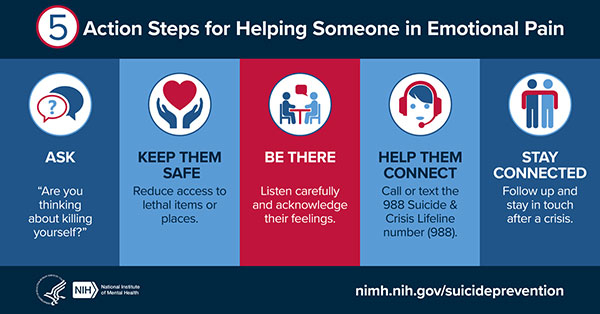Who is at risk for suicide?
 Suicide does not discriminate. People of all genders, ages, and ethnicities can be at risk for suicide. But people most at risk tend to share certain characteristics. The main risk factors for suicide are:
Suicide does not discriminate. People of all genders, ages, and ethnicities can be at risk for suicide. But people most at risk tend to share certain characteristics. The main risk factors for suicide are:
- Depression, other mental disorders, or substance abuse disorder
- A prior suicide attempt
- Family history of a mental disorder or substance abuse
- Family history of suicide
- Family violence, including physical or sexual abuse
- Having guns or other firearms in the home
- Incarceration, being in prison or jail
- Being exposed to others’ suicidal behavior, such as that of family members, peers, or media figures https://cialisfromuk.com/levitra-in-uk/.
The risk for suicidal behavior is complex. Research suggests that people who attempt suicide differ from others in many aspects of how they think, react to events, and make decisions. There are differences in aspects of memory, attention, planning, and emotion, for example. These differences often occur along with disorders like depression, substance use, anxiety, and psychosis. Sometimes suicidal behavior is triggered by events such as personal loss or violence.
In order to be able to detect those at risk and prevent suicide, it is crucial that we understand the role of both long-term factors—such as experiences in childhood—and more immediate factors like mental health and recent life events. Researchers are also looking at how genes can either increase risk or make someone more resilient to loss and hardships.
Many people have some of these risk factors but do not attempt suicide. Suicide is not a normal response to stress. It is however, a sign of extreme distress, not a harmless bid for attention.
What about gender?
Men are more likely to die by suicide than women, but women are more likely to attempt suicide. Men are more likely to use deadlier methods, such as firearms or suffocation. Women are more likely than men to attempt suicide by poisoning.
What about children?
Children and young people are at risk for suicide. Suicide is the second leading cause of death for young people ages 15 to 34.
What about older adults?
Older adults are at risk for suicide, too. While older adults were the demographic group with the highest suicide rates for decades, suicide rates for middle aged adults have increased to comparable levels (ages 24-62). Among those age 65+, white males comprise over 80% of all late life suicides.
What about different racial/ethnic groups? (USA)
Among racial and ethnic groups, American Indians and Alaska Natives tend to have the highest rate of suicides, followed by non-Hispanic Whites. Hispanics tend to have the lowest rate of suicides, while African Americans tend to have the second lowest rate.
How can suicide be prevented?
Effective suicide prevention is based on sound research. Programs that work take into account people’s risk factors and promote interventions that are appropriate to specific groups of people. For example, research has shown that mental and substance abuse disorders are risk factors for suicide. Therefore, many programs focus on treating these disorders in addition to addressing suicide risk specifically.
Psychotherapy, or “talk therapy,” can effectively reduce suicide risk. One type is called cognitive behavioral therapy (CBT). CBT can help people learn new ways of dealing with stressful experiences by training them to consider alternative actions when thoughts of suicide arise.
Another type of psychotherapy called dialectical behavior therapy (DBT) has been shown to reduce the rate of suicide among people with borderline personality disorder, a serious mental illness characterized by unstable moods, relationships, self-image, and behavior. A therapist trained in DBT helps a person recognize when his or her feelings or actions are disruptive or unhealthy, and teaches the skills needed to deal better with upsetting situations.
Medications may also help; promising medications and psychosocial treatments for suicidal people are being tested.
Still other research has found that many older adults and women who die by suicide saw their primary care providers in the year before death. Training doctors to recognize signs that a person may be considering suicide may help prevent even more suicides.

